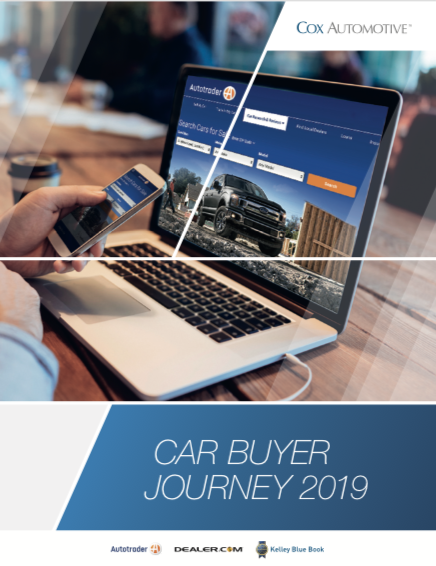Shopper Insights
2019 Car Buyer Journey Study
Tuesday June 4, 2019
Article Highlights
- Car buyers are spending less time shopping and spending fewer days in market, making decisions more quickly. They are also visiting fewer dealerships, while the number of car buyers visiting only one dealership has increased significantly to 41% (up from 30% two years ago). With car buyers making more decisions online and ahead of time, by the time many of them arrive at the dealership, they are ready to buy. As a result, dealers must have a strategy to help buyers get to “yes” online.
- Among those buyers visiting multiple websites, 65% visited a third-party site first, and 58% went to a third-party site last. Dealer sites also play an important role, especially at the end of the shopping process, where 32% of car buyers finish their online research. As a result, dealers need to have a strong presence in the online inventory marketplace.
- 61% of car buyers said their experience was not any better – and in some cases, worse – than the last time they bought a car. They are least satisfied with how long the process takes and that paperwork and negotiating are still the most frustrating parts of the car-buying process. The research shows that digital retailing is key to reducing time at the dealership.
CONSUMERS INCREASINGLY FEEL THAT OWNING A CAR IS TOO EXPENSIVE
Nearly half of consumers feel like owning or leasing a vehicle is becoming too expensive (see Diagram A).1 The percentage of vehicles costing more than $50K has, in fact, grown from 6% in 2012 to 23% in 2018. This increase in new car prices, coupled with rising interest rates, has created a bigger gap between new and used car payments.
With more shoppers concerned about monthly payment information while researching, the rate of those leaning toward a used vehicle has now grown to nearly two-in-three (see Diagram B), with more cross-shoppers also choosing used.

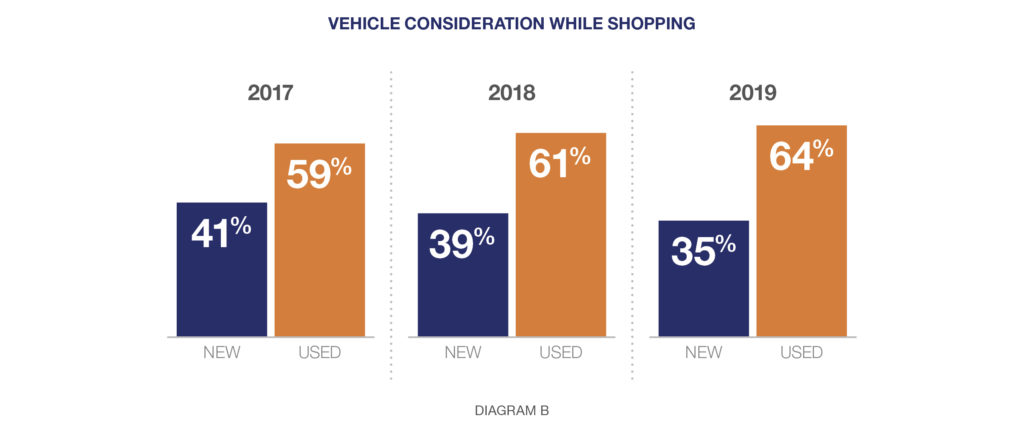
TIME SPENT SHOPPING DROPS, DAYS IN MARKET DECLINES
Car buyers are spending less time car shopping, making decisions more quickly (see Diagram C). They are also spending fewer days in market. Car buyers are now spending 96 days in market – down 22 days since 2017 (see Diagram D). This trend may be a result of increased access to online tools and better information that facilitate faster and easier decision-making, thereby creating a more efficient car-buying process.
As a result, dealers must consider new ways to more effectively compete online, including advertising that is more personalized to the shopper as well as offering more steps to the sale online through digital retailing.
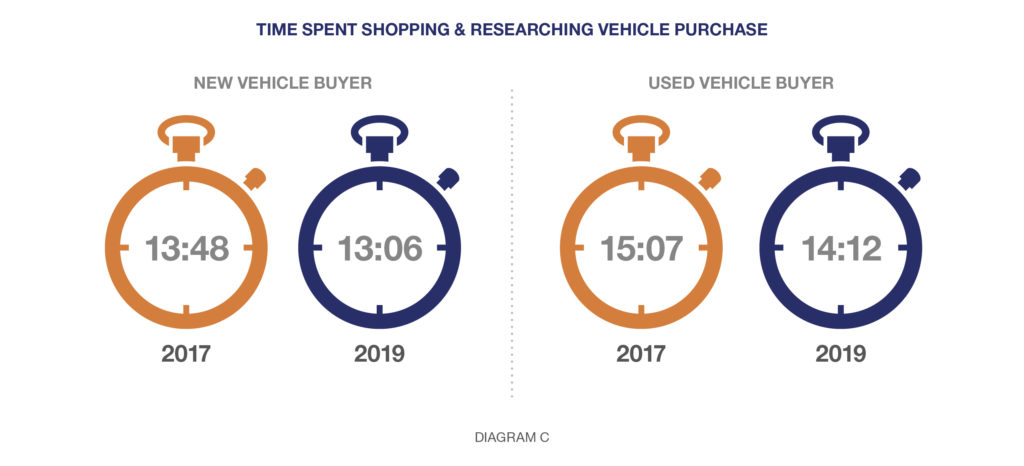

TIME SPENT SHOPPING ONLINE REMAINS CONSISTENT YEAR-OVER-YEAR
Despite the fact that car buyers are spending fewer days in market and less time shopping, the time they spend shopping online has remained stable (see Diagram E), which, in part, could be attributed to an increase in the use of multiple devices. In fact, a majority of car buyers (52%) use multiple devices to shop.
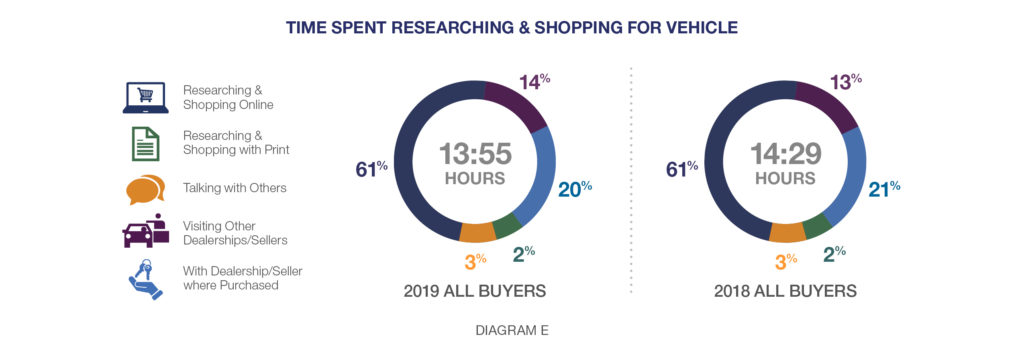
While desktop/laptops remain the most frequently used device for car shoppers, their usage has plateaued. At the same time, smartphone usage has increased 11 percentage points year-over-year (see Diagram F). This “always connected” shopper trend may help explain in part why time in market has decreased. More importantly, though, is the implication for automotive marketers: the car-shopping experience must be optimized across devices to facilitate shopping and decision-making, and yes, even transacting.
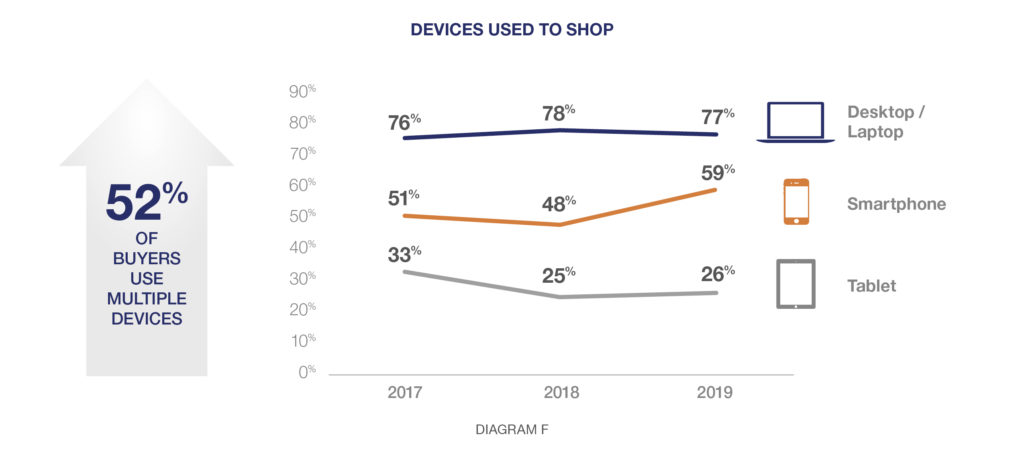
THIRD-PARTY SITES ARE THE MOST-USED SITES FOR CAR SHOPPING
While car buyers use a variety of sites to shop, third-party sites are still the most-used of any online resource. Third-party sites are the top online source for both new and used buyers, with 80% of all car buyers visiting them during the shopping process (see Diagram G).
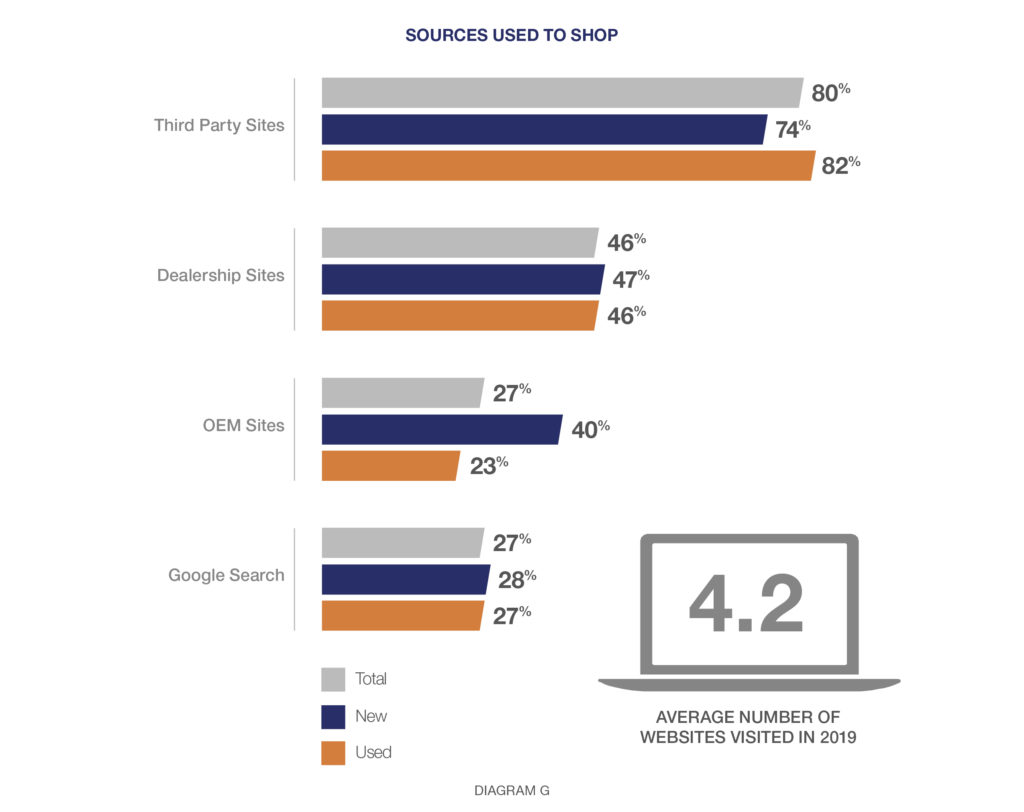
THIRD-PARTY SITES PLAY A KEY ROLE AT THE BEGINNING & END OF THE SHOPPING PROCESS
Among those buyers visiting multiple websites, 65% visited a third-party site first, and 58% went to a third-party site last (see Diagram H). Dealer websites also play an important role, especially at the end of the shopping process, where 35% of new and 31% of used car buyers finish their online research. Third-party and dealer websites are used more than OEM sites, which potentially could be attributed to third-party sites being perceived as more objective as well as where shoppers can see actual inventory for sale.
Nonetheless, dealer sites, OEM sites and search engines complement each other during the shopping process. As a result, automotive marketers should have a broad yet integrated marketing strategy, including a strong presence in the online inventory marketplace, to effectively reach and influence shoppers wherever they are shopping online.
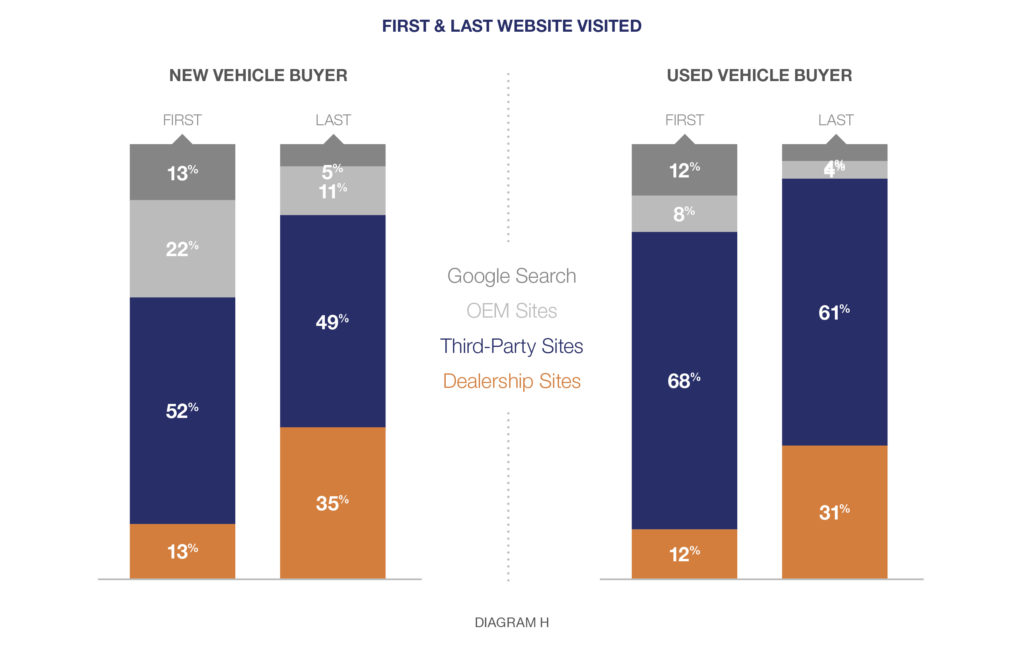
CAR BUYERS ARE VISITING FEWER DEALERSHIPS
New car buyers visit 2.5 dealerships – around the same number of dealerships they visited two years ago. Used car buyers, on the other hand, now visit 2.2 dealers – down significantly from 2.8 dealerships two years ago and now fewer than new car buyers (see Diagram I). Significantly, 41% of car buyers only visit one dealership – up 11 percentage points from two years ago (see Diagram J).


With car buyers making more decisions online and ahead of time, by the time they arrive at the dealership, many of them are likely ready to buy. As a result, dealers should hone their online marketing and sales strategy to help buyers get to “yes” online.
To influence buyers to buy your car from your dealership, consider personalizing the content – that is, making inventory recommendations based on shopper preferences as well as relevant incentives and specials.
Offering more steps to the sale, such as getting a trade- in offer, securing financing and even structuring a deal might also help increase the likelihood a shopper will buy from your dealership. In fact, 83% of consumers want to do one or more steps of the purchase process online and 7 out of 10 are more likely to buy from a dealership if they could start the process online.2
“WALKING IN” REMAINS MOST-COMMON INITIAL POINT OF CONTACT WITH DEALERS
In-person visits are still the primary way car buyers make initial contact with a dealer (see Diagram K). In fact, 49% of new car buyers and 53% of used car buyers do not contact the dealership prior to their first visit. However, the way car buyers prefer to communicate with dealerships is gradually changing with the expanded use of technology. Phone and email contact is down since 2018, while online chat and text have grown as the first point of contact.
A future shift in this behavior is likely to continue as dealers begin to adopt digital retailing tools. Nevertheless, it remains crucial for dealers to have effective sourcing and CRM processes in place to help understand initial contacts and walk-in traffic. Knowing what influenced a shopper to contact the dealership, regardless of method, can help dealers determine the value of their advertising and understand where to most successfully invest marketing dollars.
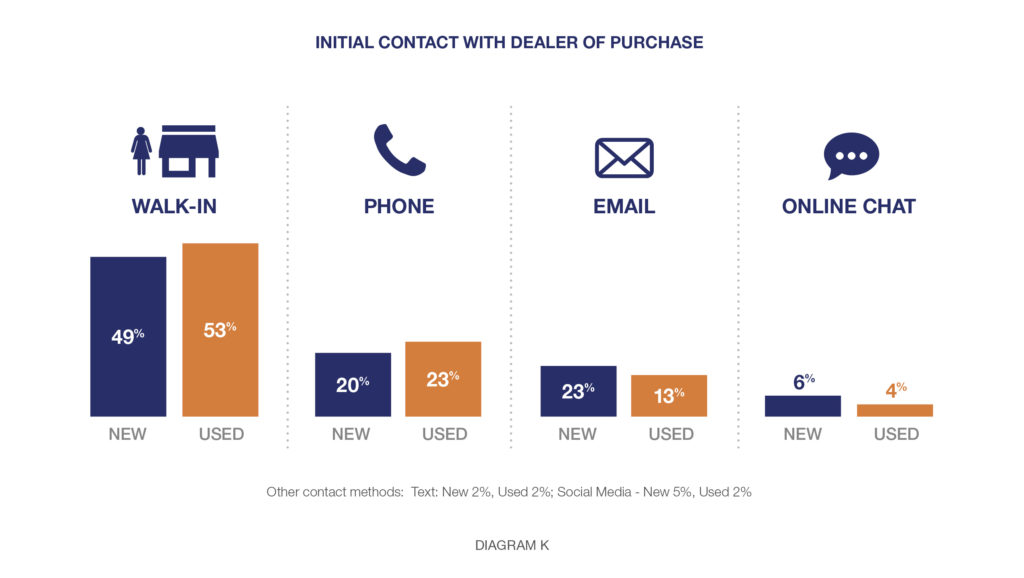
THE BUYING EXPERIENCE HAS NOT IMPROVED
When asked to compare their most recent buying experience to previous ones, 61% of car buyers said their experience was not any better – and in some cases, worse – than the last time they bought a car (see Diagram L). Car buyers indicate that, when it comes to the dealership experience, they are least satisfied with how long the process takes (see Diagram M) and that paperwork and negotiating are still the most frustrating parts of the car-buying process (see Diagram N). So it’s no surprise that those buyers who say their dealership experience was better spent significantly less time at the dealership, specifically negotiating and signing paperwork (see Diagram O).

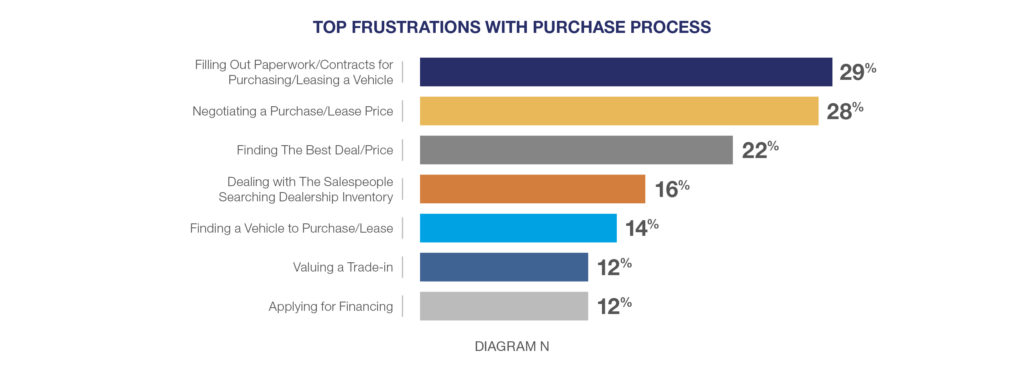

When it comes to the car-buying experience and the amount of time car buyers spend at the dealership, customer satisfaction begins to decline after 90 minutes (see Diagram P). Yet, car buyers are spending nearly three hours at the dealership making their purchase according to this latest research (see Diagram Q).
Despite more efficiencies in the car-shopping process that have likely contributed to fewer days in market and less total time shopping, there is still a lot of opportunity for similar efficiencies to be gained in the showroom.
Reducing the time it takes for car buyers to complete their purchase in-store could improve the customer experience, which is not only essential for closing sales today but also for creating loyal customers who come back for service and future purchases.
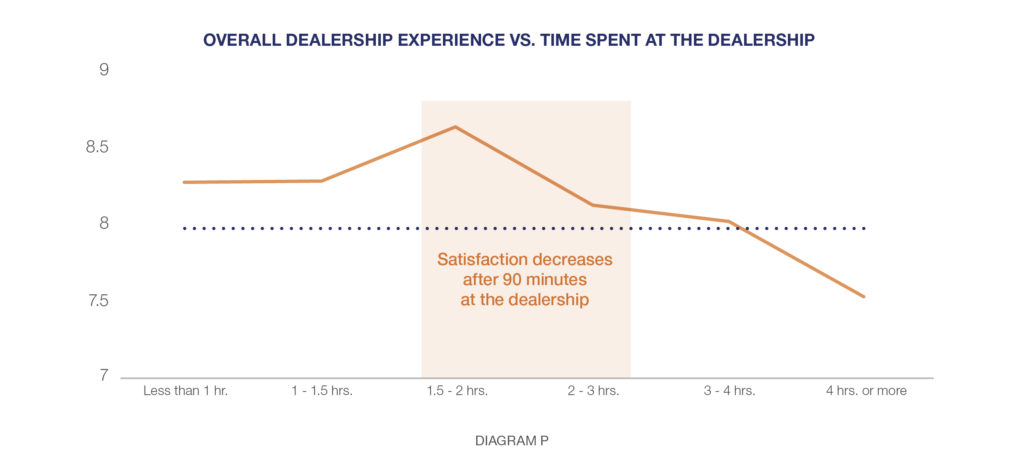
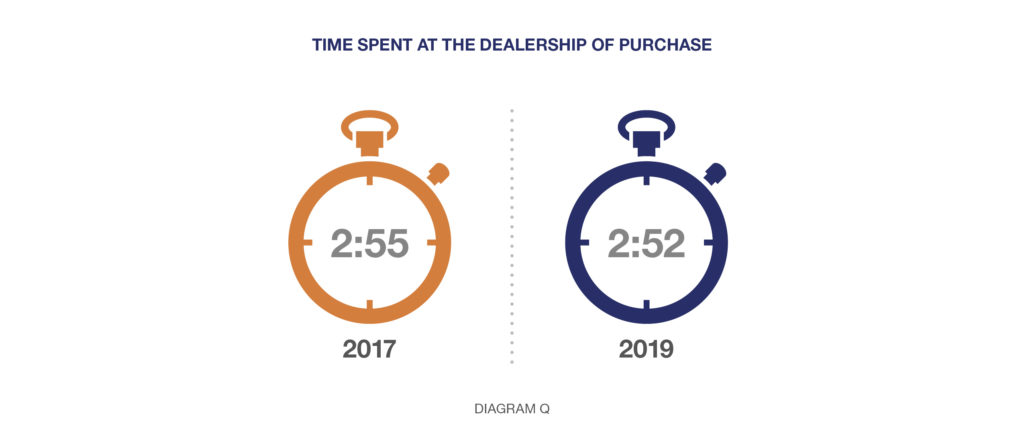
DIGITAL RETAILING IS KEY TO REDUCING TIME AT THE DEALERSHIP
When key retail activities such as the trade-in offers, negotiations, paperwork and aftermarket sales are handled at the dealership, buyers often spend up to three or more hours in the showroom. When any of these activities are handled online, the time spent at the dealership drops significantly (see Diagram R).

The most frequent tasks performed online include searching for vehicles, finding trade-in value, getting information on incentives and securing credit/financing. When it comes to the more transaction-oriented (and frustrating) steps like finalizing price, doing paperwork and negotiating, less than 10% of buyers perform these activities online ahead of time (see Diagram S), likely because access and availability of these options are currently limited.
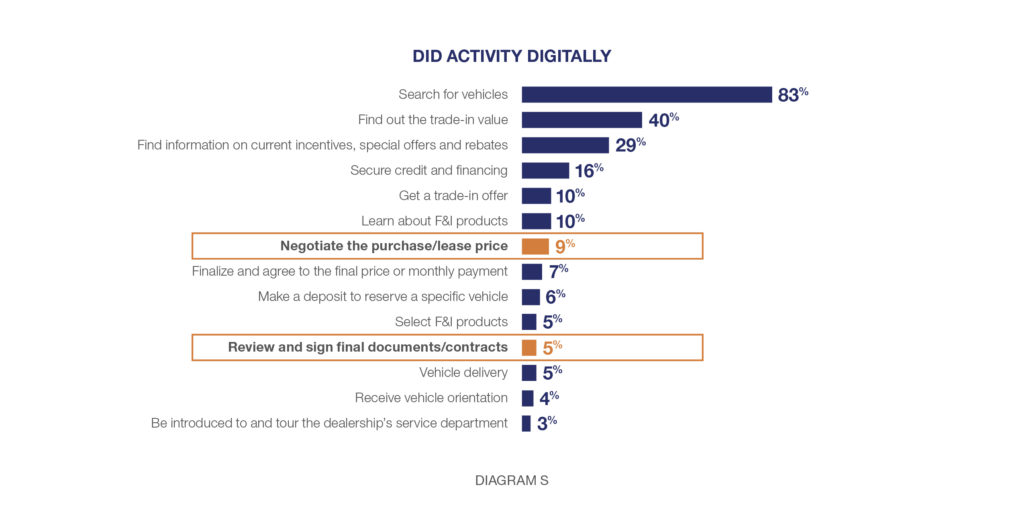
Dealers should strive to shorten the deal-making process – particularly through streamlining F&I paperwork and negotiations. By making more steps to the sale available online before customers arrive at the store, dealers can reduce the amount of time spent on the deal at the dealership, thereby positively impacting customer satisfaction.
ABOUT THIS STUDY
For the past 10 years, Cox Automotive has conducted studies designed to gain an understanding of car shopping and buying behavior along with perceptions of the dealer experience.The 2019 Car Buyer Journey is based on a survey of 3,086 recent vehicle buyers (1,047 used/ CPO and 2,039 new vehicle buyers) who purchased their vehicle within the last 12 months and used the internet during the shopping and buying process.
